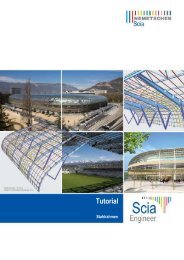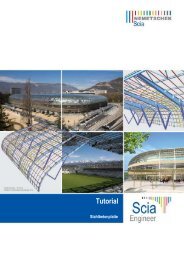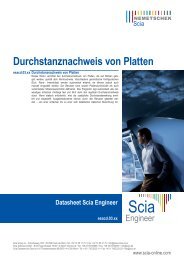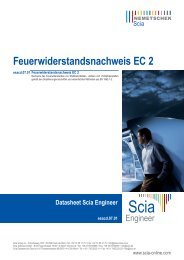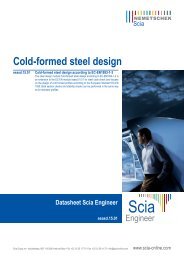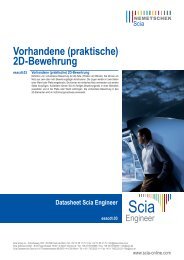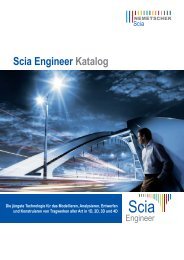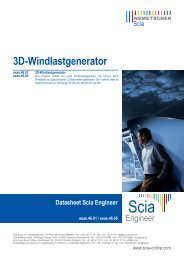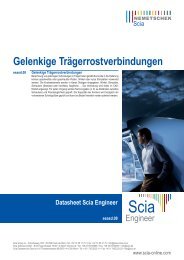Advanced Package Training Scaffolding 2011.1 - Scia-Software GbR
Advanced Package Training Scaffolding 2011.1 - Scia-Software GbR
Advanced Package Training Scaffolding 2011.1 - Scia-Software GbR
Create successful ePaper yourself
Turn your PDF publications into a flip-book with our unique Google optimized e-Paper software.
Load Case 1: Self Weight<br />
15<br />
<strong>Scaffolding</strong><br />
In this load case the complete self weight of the structure is included, including the toeboards, floor<br />
board elements, ...<br />
This load case is automatically calculated by <strong>Scia</strong> Engineer.<br />
Load Case 2: Self Weight of the toeboards (and other structural members)<br />
The self weight of the toeboards can be calculated as follows:<br />
Surface area of the profile = 15 cm x 2 cm = 30 cm² = 30 x 10 -4 m²<br />
Density of the toeboard = 773.3 kg/m³<br />
Weight of the toaboard per meter = 30 x 10 -4 m² x 773.3 kg/m³ = 2.32 kg/m<br />
Line load: 2.32 x 9.81 N/m = 22,76 N/m = 0,023 kN/m<br />
Load Case 3: Service load Main floor<br />
This load case represents the service load that operates over the entire main floor. “Main floor”<br />
means the most important/crucial floor of the scaffolding. If the load is put on this floor, it leads to the<br />
most critical values.<br />
In this example, a class 3 scaffolding has been inserted, so a divided load of 200 kg/m², or 2 kN/m²<br />
(EN12811-1 Table 3). This is transferred to floor boards.<br />
Load Case 4: Service load Secondary floor<br />
Analogous to load case 2, the service load in this load case is entered on the complete secondary<br />
floor. Secondary floor refers to the working area at the first level above or below the main floor.<br />
According to the code EN12811-1, 50% of the service load has to be put on the secondary floor.<br />
Load Case 5: Service load 25%<br />
This load case represents an accumulation of materials and equipments for the complete main<br />
working area, when the scaffolding is subject to the maximal wind load.<br />
Note<br />
In some cases it can be necessary to input a non symmetric load on the construction. So it can be<br />
important to input a load case, completely analogous to load case 3, 4 or 5, but here the service load<br />
is only put on half of the main floor. By executing this load case, the structure is eccentrically loaded,<br />
so effects that counterbalance each other in a symmetrical load, are revealed here.<br />
Example:



